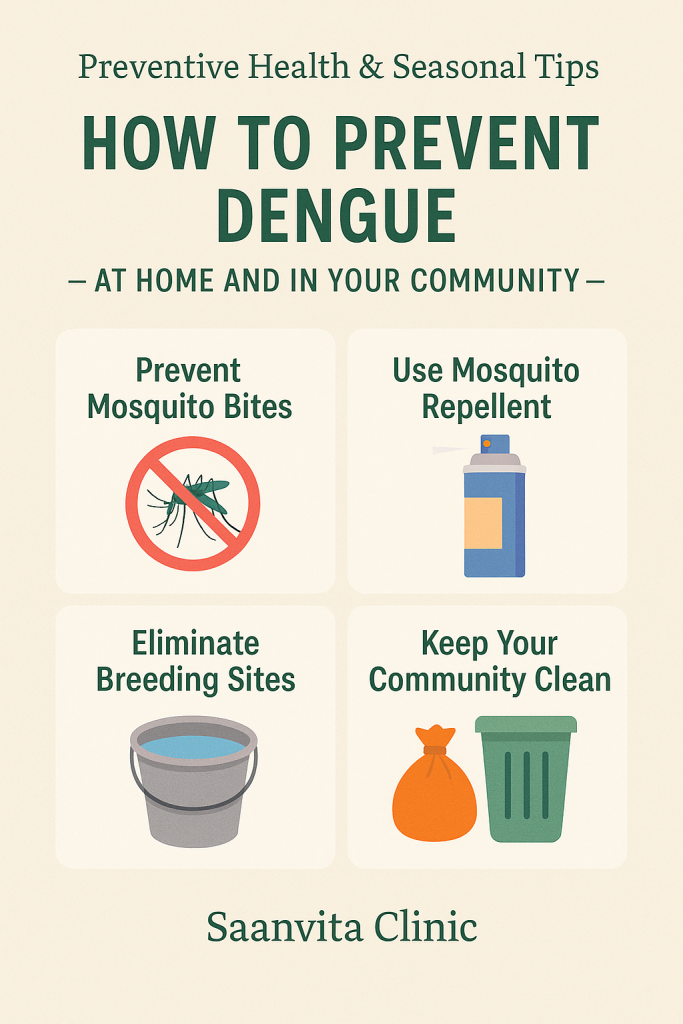1. What triggers a dengue outbreak?
- The virus family. Dengue fever is caused by four related viruses (labelled DENV-1 through DENV-4). Immunity to one type does not guarantee protection from the other three, which explains why repeat infections happen.
- The day-biting mosquito. Aedes aegypti—and, to a lesser extent, Aedes albopictus—spreads all four viruses. These mosquitoes prefer clean, still water in tanks, roof gutters, coolers, flower pots, construction sites and even discarded bottle caps. They are most active from sunrise to sunset.
2. Recognising the illness early
Common symptoms (day 3-7 after a bite)
- Sudden fever (≥ 101 °F)
- Severe headache, often behind the eyes
- Intense muscle and joint pain (“break-bone” feeling)
- Nausea, occasional vomiting
- Fine red rash and mild gum- or nose-bleeds
Danger signs that need hospital care
- Persistent vomiting or severe stomach pain
- Rapid breathing or unexplained restlessness
- Bleeding in stool, urine or vomitus
- Very tired, cold or clammy skin
These warning signals often show up after the fever settles, usually between day 4 and day 7.
3. Steps to take if dengue is suspected
- Confirm early. Ask for an NS1 antigen test and a complete blood count (CBC) within the first five days of fever.
- Hydrate aggressively. Aim for 3–4 litres of fluids daily—water, ORS, clear soups, coconut water.
- Use paracetamol only. Ibuprofen, aspirin and other NSAIDs raise the risk of bleeding.
- Track platelets and haematocrit daily from day 4 until clearly improving.
- Know the admission criteria. Any danger sign, platelets below 50,000/mm³, rising haematocrit, pregnancy, infants, elderly patients or people with chronic disease should be observed in hospital.
(Saanvita Clinic provides same-day NS1/IgM testing, CBC monitoring . Call 9060640666 for appointments.)
4. Prevention — household and community actions
- “Tip, empty, scrub” every week. Dispose of or cover any container that can hold water. Pay extra attention after every rain shower.
- Protect your skin from dawn to dusk. Wear long sleeves and apply a repellent that contains DEET, Picaridin or IR3535.
- Keep mosquitoes outside. Install fine-mesh window screens and repair torn nets.
- Support civic drives. Let vector-control workers inspect your premises and report clogged drains or construction sites that collect water.
- Understand vaccine reality. Candidate vaccines in India are still under evaluation or suitable only for people who have had dengue before, so mosquito control remains the front-line defence.
5. Dengue burden in numbers
| Year | India – reported cases | India – deaths | Delhi – reported cases | Delhi – deaths* |
|---|---|---|---|---|
| 2023 | 2,89,235 | 485 | 16,866 | 19 |
| 2024 | 2,33,519 | 297 | 10,585 | 11 |
| 2025† | 13,052 | 19 | ~200 | 0 |
*Municipal Corporation of Delhi figures. †Data up to 31 July 2025 (National Centre for Vector Borne Disease Control).
Globally, the World Health Organization logged more than 7.6 million cases and over 3,000 deaths in just the first four months of 2024—the fastest rise on record.
6. Why dengue refuses to disappear from Delhi-NCR
- Countless micro-breeding sites. Rooftop tanks, new construction and unplanned water storage create millions of hidden puddles that fogging can’t reach.
- Longer breeding seasons. Warmer, wetter weather and urban “heat islands” let mosquitoes thrive nearly year-round.
- Chemical resistance. Aedes aegypti is increasingly tolerant of common insecticides, forcing health workers to rotate chemicals.
- Seamless human movement. Daily commuters shuttle the virus between Delhi, Gurugram, Noida, Faridabad and Ghaziabad before symptoms start.
- Patchy community compliance. Repeated fines have not stopped households and building sites from letting water accumulate.
- No widely deployable vaccine—yet. Current candidates need prior exposure checks or are awaiting approval, so herd immunity remains out of reach.
- Silent infections. Up to four in five dengue infections cause no obvious illness, letting the virus spread under the radar.
7. How Saanvita Clinic supports you
- Rapid diagnostics and daily platelet monitoring
- Free bilingual posters (English / Hindi) for housing societies and schools
Bottom line
Dengue can be beaten back, but only if every household treats stagnant water as a public hazard. With vigilant clean-up, personal protection and early medical care, Delhi-NCR can keep 2025 numbers low—and save lives along the way.
Feeling unwell? Book a same-day review at Saanvita Clinic, Jay Kalka Complex, Chhatarpur. Early detection saves lives.
